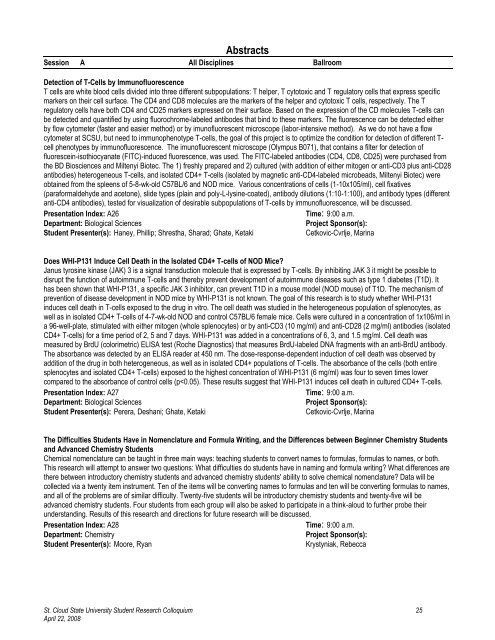2008 Proceedings - St. Cloud State University
2008 Proceedings - St. Cloud State University
2008 Proceedings - St. Cloud State University
You also want an ePaper? Increase the reach of your titles
YUMPU automatically turns print PDFs into web optimized ePapers that Google loves.
Abstracts<br />
Session A All Disciplines Ballroom<br />
Detection of T-Cells by Immunofluorescence<br />
T cells are white blood cells divided into three different subpopulations: T helper, T cytotoxic and T regulatory cells that express specific<br />
markers on their cell surface. The CD4 and CD8 molecules are the markers of the helper and cytotoxic T cells, respectively. The T<br />
regulatory cells have both CD4 and CD25 markers expressed on their surface. Based on the expression of the CD molecules T-cells can<br />
be detected and quantified by using fluorochrome-labeled antibodes that bind to these markers. The fluorescence can be detected either<br />
by flow cytometer (faster and easier method) or by imunofluorescent microscope (labor-intensive method). As we do not have a flow<br />
cytometer at SCSU, but need to immunophenotype T-cells, the goal of this project is to optimize the condition for detection of different T-<br />
cell phenotypes by immunofluorescence. The imunofluorescent microscope (Olympus B071), that contains a filter for detection of<br />
fluorescein-isothiocyanate (FITC)-induced fluorescence, was used. The FITC-labeled antibodies (CD4, CD8, CD25) were purchased from<br />
the BD Biosciences and Miltenyi Biotec. The 1) freshly prepared and 2) cultured (with addition of either mitogen or anti-CD3 plus anti-CD28<br />
antibodies) heterogeneous T-cells, and isolated CD4+ T-cells (isolated by magnetic anti-CD4-labeled microbeads, Miltenyi Biotec) were<br />
obtained from the spleens of 5-8-wk-old C57BL/6 and NOD mice. Various concentrations of cells (1-10x105/ml), cell fixatives<br />
(paraformaldehyde and acetone), slide types (plain and poly-L-lysine-coated), antibody dilutions (1:10-1:100), and antibody types (different<br />
anti-CD4 antibodies), tested for visualization of desirable subpopulations of T-cells by immunofluorescence, will be discussed.<br />
Presentation Index: A26<br />
Time: 9:00 a.m.<br />
Department: Biological Sciences<br />
Project Sponsor(s):<br />
<strong>St</strong>udent Presenter(s): Haney, Phillip; Shrestha, Sharad; Ghate, Ketaki<br />
Cetkovic-Cvrlje, Marina<br />
Does WHI-P131 Induce Cell Death in the Isolated CD4+ T-cells of NOD Mice?<br />
Janus tyrosine kinase (JAK) 3 is a signal transduction molecule that is expressed by T-cells. By inhibiting JAK 3 it might be possible to<br />
disrupt the function of autoimmune T-cells and thereby prevent development of autoimmune diseases such as type 1 diabetes (T1D). It<br />
has been shown that WHI-P131, a specific JAK 3 inhibitor, can prevent T1D in a mouse model (NOD mouse) of T1D. The mechanism of<br />
prevention of disease development in NOD mice by WHI-P131 is not known. The goal of this research is to study whether WHI-P131<br />
induces cell death in T-cells exposed to the drug in vitro. The cell death was studied in the heterogeneous population of splenocytes, as<br />
well as in isolated CD4+ T-cells of 4-7-wk-old NOD and control C57BL/6 female mice. Cells were cultured in a concentration of 1x106/ml in<br />
a 96-well-plate, stimulated with either mitogen (whole splenocytes) or by anti-CD3 (10 mg/ml) and anti-CD28 (2 mg/ml) antibodies (isolated<br />
CD4+ T-cells) for a time period of 2, 5 and 7 days. WHI-P131 was added in a concentrations of 6, 3, and 1.5 mg/ml. Cell death was<br />
measured by BrdU (colorimetric) ELISA test (Roche Diagnostics) that measures BrdU-labeled DNA fragments with an anti-BrdU antibody.<br />
The absorbance was detected by an ELISA reader at 450 nm. The dose-response-dependent induction of cell death was observed by<br />
addition of the drug in both heterogeneous, as well as in isolated CD4+ populations of T-cells. The absorbance of the cells (both entire<br />
splenocytes and isolated CD4+ T-cells) exposed to the highest concentration of WHI-P131 (6 mg/ml) was four to seven times lower<br />
compared to the absorbance of control cells (p
















